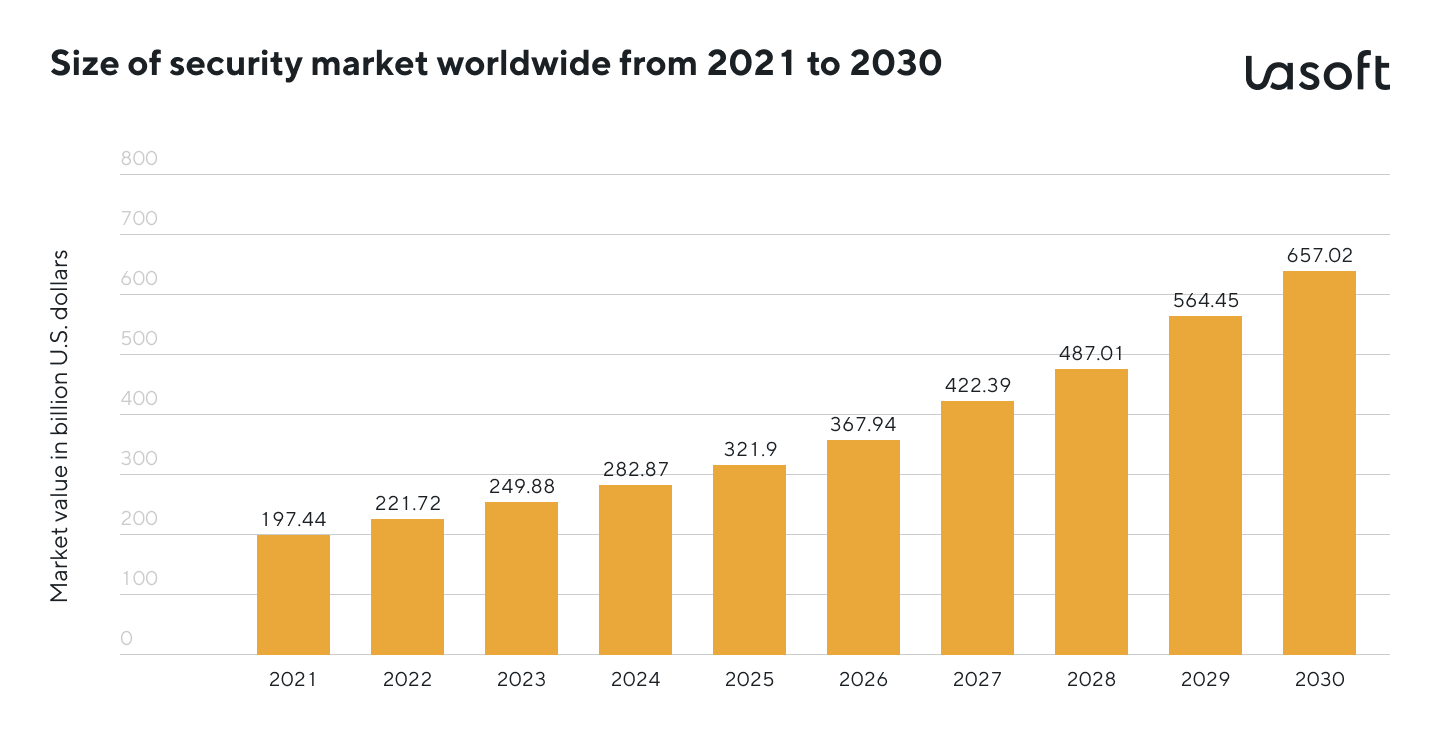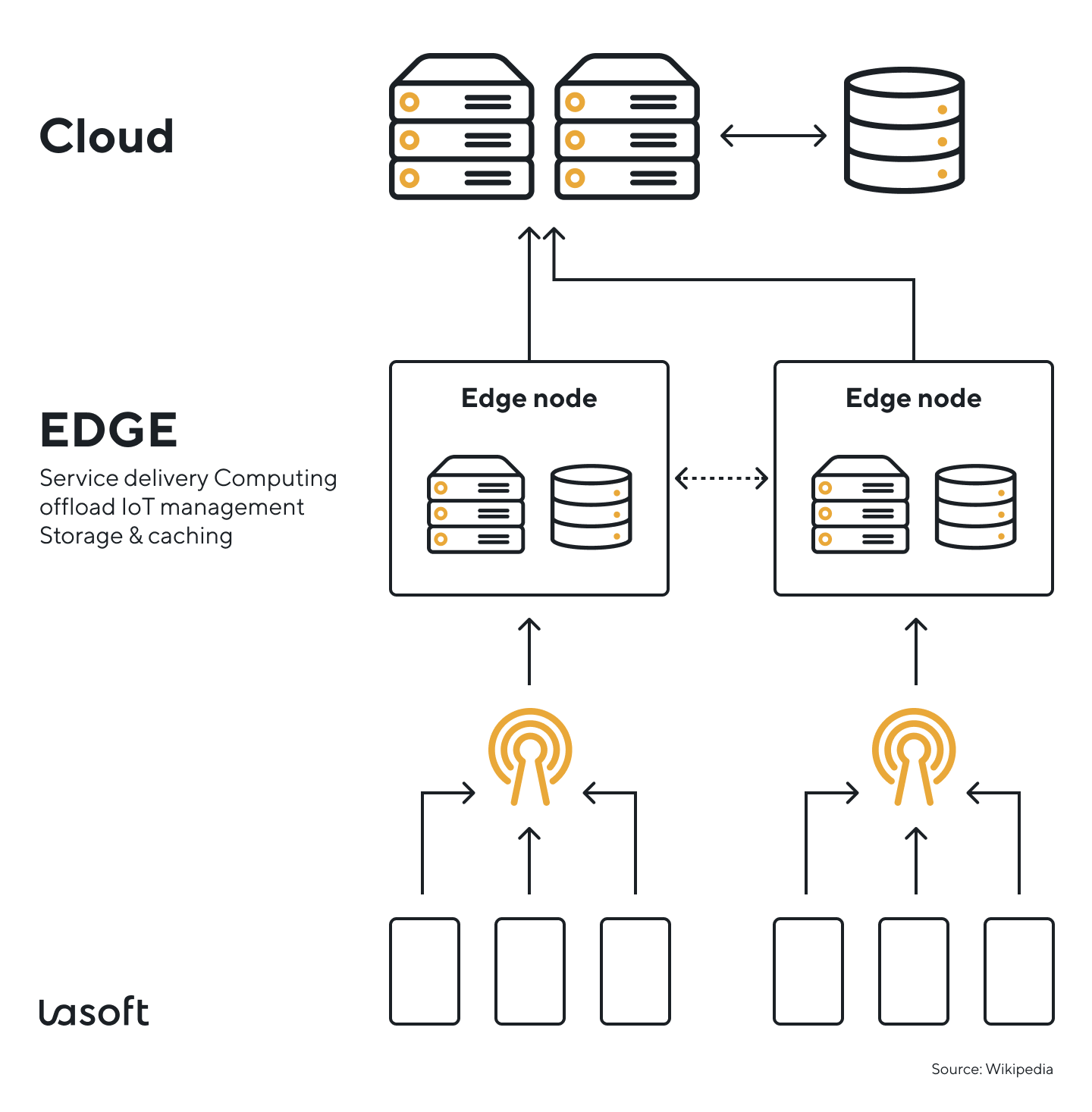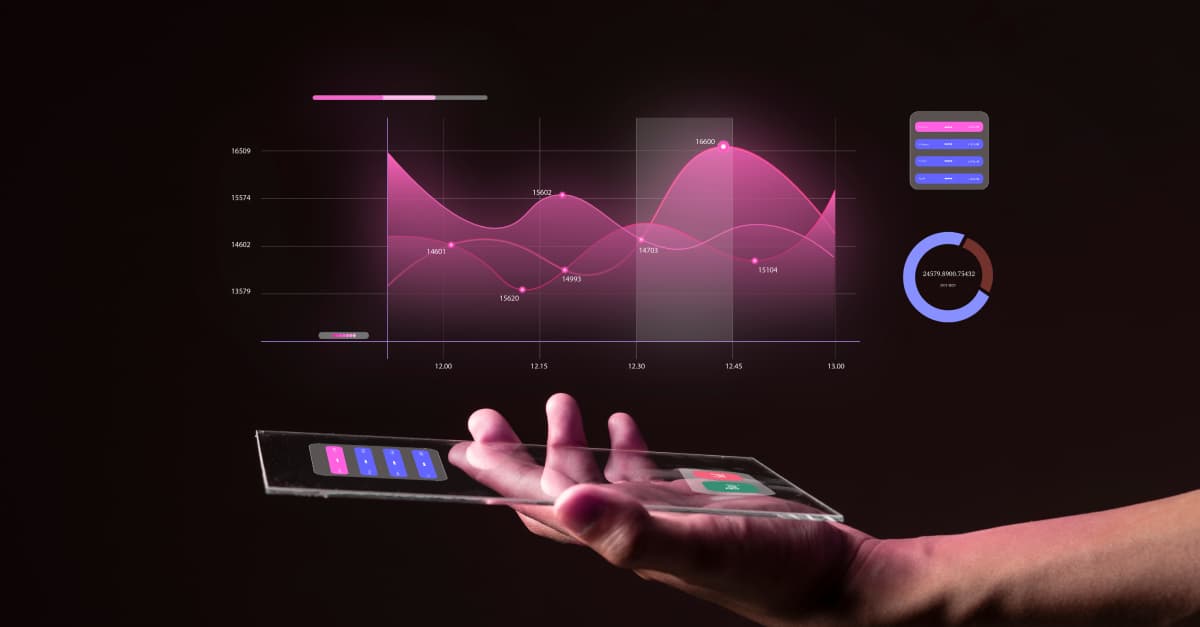In 2024 the software development industry will face rapid technological advancement as well as new security challenges. The importance of evaluating risks, testing continuously & ensuring compliance is essential prior to full-scale product deployment. Software development is transforming the way we live in the future. This year we witnessed obsession over AI/ML resulting from generative artificial intelligence. The focus of the year remained on finding an optimal balance between efficiency and security.
Let’s look at some of the top software development trends for 2024 that CEOs should be aware of now. From cloud computing to artificial intelligence, we’ll explore emerging tech that’s revolutionizing businesses across the IT industry. We’ll discuss how this new global software development landscape will affect user experience, identify potential opportunities for startups wanting to enter this space and see how best practices are transforming alongside ever-evolving customer expectations. Companies looking to thrive during this exciting digital revolution must begin preparing now if they want to remain competitive in the coming years!
The Impact of AI and Machine Learning on Software Development
With the rise of Artificial Intelligence and Machine Learning, we are witnessing some pretty impressive advancements in the field. Developers are now able to automate routine tasks, streamline workflows, and ultimately build better software in less time. But the impact of AI and Machine Learning on software development goes beyond just increasing efficiency. These technologies are also enabling developers to create more intelligent software, with the ability to learn from user interactions and adapt to changing situations:
Improved User Interface |
To deliver individualized and simple-to-use user experiences, AI and ML algorithms can evaluate user behavior, preferences, and interactions. Increased user retention, engagement, and satisfaction are the results. |
ML for Better Analytics |
Companies can obtain accurate data to predict user patterns, inclinations, and possible problems. |
Automation of Tasks |
AI simplifies automating time-consuming, repetitive processes in the development process. It enables developers to concentrate on more intricate and imaginative parts of creating apps and websites. |
Effective Bug Detection and Debugging |
ML algorithms can analyze code patterns to find any flaws or bugs. |
Improvements in Security |
AI and ML can assess user behavior, detect anomalies, and protect against cybersecurity threats, which can ensure a secure digital environment. |
Virtual Assistants and Chatbots |
Chatbots and virtual assistants powered by AI improve customer service and engagement. |
Increased Focus on DevOps Approaches to Reduce Time-To-Market
In an attempt to bridge the gap between software development and IT operations—two vital but frequently misaligned endeavors—DevOps is a collection of adaptable software production and delivery techniques. It’s a tactical approach rather than a particular technology that helps development and operations teams remove obstacles and concentrate on enhancing software development, deployment, and ongoing monitoring by cooperating.
As companies continue to compete for a piece of the market share, there’s been an increased focus on DevOps approaches to speed up software development and reduce the time-to-market. By breaking down traditional silos between teams and promoting collaboration, DevOps practices can streamline the entire development cycle – from planning and coding to testing and deployment. Not only does this accelerate the delivery of new features and updates, but it also helps reduce errors and improves overall software quality.
Nearshore Dedicated Teams
Have you ever heard of nearshore dedicated teams in software development? They are becoming increasingly popular in the tech industry, and for good reason. Essentially, a nearshore dedicated team is a group of software developers working remotely but located in a nearby country or time zone. This allows for effective communication and collaboration with your development team without dealing with the constraints of different time zones and language barriers. Plus, you get the added benefit of having a team dedicated solely to your project, meaning they are fully invested in its success. It’s a win-win situation for everyone involved. So next time you want to expand your tech team, consider trying a nearshore dedicated team.
Reducing Our Environmental Footprint With Sustainable Software
There’s a tendency towards a sustainable future in software development. It’s not just about crafting applications; it’s about crafting a greener world. Sustainable software development principles guide developers towards eco-friendly solutions that minimize environmental impact. Despite this, many companies still cling to outdated practices, contributing to vast energy consumption and perpetuating unconscious software development.
The explosion of software usage has fueled an unprecedented deluge of data. Our interactions with software generate vast amounts of information, commonly called “big data.” This data fuels machine learning algorithms, artificial intelligence, and data-driven decision-making processes. It’s a valuable resource that drives innovation across industries, empowering businesses to enhance customer experiences, optimize supply chains, and develop cutting-edge products and services.
Embracing sustainable practices is vital and isn’t just about mitigating energy consumption and waste; it’s about delivering superior products that resonate with environmentally-conscious consumers. Some vital steps developers can take to build sustainable digital products:
1. Carbon Efficiency: Minimizing Environmental Footprints
Central to sustainable software development is reducing the carbon footprint throughout a product’s lifecycle. This entails meticulous attention to optimizing processes, minimizing resource consumption, and leveraging renewable energy sources wherever possible.
2. Electricity Efficiency: Designing for Energy Conservation
Efficiency is paramount when it comes to energy usage. Developers can significantly decrease electricity consumption by incorporating energy-efficient features into software design without compromising performance or functionality.
3. Hardware Efficiency: Maximizing Performance, Minimizing Waste
Responsible utilization of computing resources is essential for minimizing energy consumption. By prioritizing efficiency in hardware usage, developers can strike a balance between performance and environmental management.
4. Network Efficiency: Streamlining Data Transfers
Reducing carbon emissions related to data transfers are critical in sustainable software development. Developers can minimize environmental impact by employing strategies to optimize network efficiency while maintaining seamless connectivity.
5. Measurement for Sustainability: Tracking Progress, Driving Improvement
Effective sustainability initiatives hinge on robust measurement and analysis. By diligently tracking environmental impact metrics, developers can identify areas for improvement and drive continuous enhancement in sustainability practices.
6. Sustainable Goals: Prioritizing Environmental Responsibility
Setting clear sustainability metrics is fundamental to driving meaningful change. By considering environmental, societal, and economic factors, developers can align their goals with broader sustainability objectives, fostering a holistic approach to software development.
7. Lean and Agile Tools: Iterative Improvement, Minimal Waste
Adopting lean and agile methodologies is essential for promoting iterative improvement and minimizing waste in software development processes. By prioritizing user feedback and rapid iteration cycles, developers can enhance sustainability while delivering value to end-users.
8. “Green Coding” Concept: Harnessing Environmental Consciousness
Embracing the “green coding” concept involves designing software with environmental impact in mind. By prioritizing energy-efficient algorithms, resource optimization, and sustainable design principles, developers can contribute to a greener, more sustainable future.
9. Choosing Modern Tools: Aligning with Sustainability Goals
Selecting technologies that align with sustainability goals is crucial for sustainable software development. By leveraging modern tools and frameworks designed with environmental considerations in mind, developers can future-proof their applications and drive positive ecological outcomes.
Cybersecurity and Data Security
As technology advances, the significance of cybersecurity and data protection in software development has never been more crucial. In 2024, several trends are shaping the landscape, ensuring companies stay ahead of evolving security challenges and threats. There’s constant size growth in the cybersecurity market worldwide according to Statista.

Source: Statista
Rise of Zero Trust Architecture and Biometric Authentication
As traditional password-based authentication faces challenges, biometric authentication and zero-password solutions are gaining traction. Software developers will focus on incorporating secure biometric authentication methods and exploring innovative zero-password approaches to enhance user security. Adopting a Zero Trust approach, where trust is never assumed, requires verification from anyone trying to access resources, regardless of their location.
Integration of Artificial Intelligence (AI) and Machine Learning (ML)
AI and ML are becoming integral components of cybersecurity strategies. These technologies enhance threat detection, automate responses to security incidents, and provide predictive analytics to anticipate potential vulnerabilities. In 2024, expect to see further integration of AI and ML in software development for proactive threat mitigation.
Quantum-Safe Cryptography
Quantum computing is a quickly developing technology that can handle issues too complicated for traditional computers. With the advent of quantum computing, traditional cryptographic methods face potential vulnerabilities. Quantum-safe cryptography is emerging as a proactive measure to secure data against the future threat of quantum computers. Software developers are likely to incorporate quantum-resistant encryption algorithms in their solutions.
Container Security
As containerization gains traction in software development, ensuring the security of containerized applications becomes paramount. In 2024, developers will focus on implementing robust container security measures, including vulnerability scanning, image signing, and runtime protection, to safeguard applications deployed in containerized environments.
DevSecOps Integration
DevSecOps, integrating security practices into the DevOps pipeline, is not just a methodology but a cultural shift. In 2024, organizations will emphasize DevSecOps, fostering collaboration between development, operations, and security teams from the early stages of the software development lifecycle.
Cloud Infrastructure as a Trend
As of now, the cloud infrastructure market is booming. With notable players dominating the industry and a slew of services catering to diverse needs, the numbers speak for themselves. Market trends and statistics showcase the widespread adoption of cloud solutions across various sectors.
Factors Driving Cloud Infrastructure Growth
Several factors contribute to the unprecedented growth of cloud infrastructure. The increased demand for digital transformation, coupled with advancements in technology, creates a fertile ground for the expansion of cloud services globally. Regardless of their scale, businesses recognize the need to harness the power of the cloud for sustainable growth.
Challenges and Opportunities
While the advantages of cloud infrastructure are abundant, challenges do exist. Security and scalability issues often loom, allowing businesses to fortify their operations and explore new solutions.
Key Technologies Shaping Cloud Infrastructure
The synergy between cloud infrastructure and cutting-edge technologies is reshaping the digital landscape. Edge computing, artificial intelligence, and blockchain applications are becoming integral components, enhancing the capabilities and efficiency of cloud services. Emerging trends, such as the integration of 5G and the proliferation of edge computing, are set to redefine the landscape.
Adoption of Hybrid Cloud Solutions
Businesses increasingly opt for hybrid cloud solutions, balancing on-premises infrastructure and public cloud services. This approach offers automated and scalable solution, flexibility, and cost-effectiveness, with real-world examples showcasing its success.
Edge Computing and Decentralized Applications in the Blockchain
Edge Computing marks a paradigm shift from centralized cloud architecture to a decentralized approach. In 2024, the proliferation of edge computing will reshape how data is processed and analyzed. Edge devices, closer to the data source, enable faster processing, reduced latency, and enhanced real-time decision-making.
Integration with Internet of Things (IoT)
Edge Computing seamlessly integrates with the Internet of Things (IoT), providing a decentralized infrastructure for IoT devices. This synergy optimizes data processing and addresses latency concerns, making it an ideal solution for applications requiring instant responses, such as smart cities and autonomous vehicles.
Decentralized Applications (DApps) on the Blockchain
Blockchain technology continues to disrupt traditional paradigms, and in 2024, the focus is on Decentralized Applications (DApps). DApps run on a decentralized network of computers, ensuring transparency, security, and immutability. They eliminate the need for intermediaries, empowering users with greater control over their data and transactions.
Smart Contracts and Automation
Smart contracts, self-executing contracts with the terms of the agreement directly written into code, play a pivotal role in DApps. In the following years, the automation capabilities of smart contracts will expand, enabling secure and trustless execution of agreements without the need for intermediaries.
Interoperability between Edge Computing and Blockchain
The convergence of Edge Computing and Blockchain facilitates new possibilities. Edge devices can participate in blockchain networks, contributing to consensus mechanisms and securely storing data on distributed ledgers. This interoperability enhances the overall efficiency and trustworthiness of decentralized systems.
Enhanced Security through Decentralization
Decentralization inherent in both Edge Computing and Blockchain contributes to enhanced security. The focus is on leveraging the distributed nature of these technologies to thwart cyber threats, ensuring data integrity, and protecting sensitive information from single points of failure.
Tokenization and Digital Assets
Blockchain enables tokenization, representing real-world assets in a digital form. These assets, tokens, can mean anything from real estate to art, providing new avenues for investment and ownership.
Decentralized Finance (DeFi) Evolution
Decentralized Finance, a subset of DApps, is evolving rapidly. We will see an expansion of DeFi services, including decentralized lending, borrowing, and trading. These financial services operate without traditional intermediaries, offering increased accessibility, inclusivity, and secure and efficient transactions.
Energy Efficiency in Edge Computing
As sustainability becomes a priority, Edge Computing is adapting to be more energy-efficient. In 2024, advancements in hardware and optimization algorithms aim to minimize energy consumption, making Edge Computing faster and a modern software development ecosystem environmentally friendly.

Continued Expansion of The IoT
We’re witnessing an unprecedented surge in the number and diversity of connected devices, ranging from smart home gadgets to industrial sensors, contributing to creating a more interconnected world. The deployment and adoption of 5G networks are catalysts for the expansion of IoT. With faster speeds and lower latency, 5G empowers a new era of connected devices that demand quick and reliable data transmission. In 2024, we’ll see accelerated IoT growth as 5G becomes more widespread.
As we mentioned above, IoT devices are generating massive amounts of data, and the integration of Edge Computing is a response to this challenge. We anticipate a seamless integration of Edge Computing with IoT, allowing data processing closer to the source, reducing latency, and enhancing overall efficiency. Statista forecasts that the IoT market is anticipated to grow at an annual growth rate of 13.60% (CAGR 2023-2028), resulting in a remarkable market volume of US$2,227.00bn by 2028.
The Rise of Low-Code and No-Code Development Tools
The rise of low-code and no-code development tools has made it easier than ever for non-technical folks to bring their ideas to life. These tools allow users to visually create applications through drag-and-drop interfaces without knowing how to code. With no-code platforms, you can use a visual interface to design and build your app, while low-code solutions offer a bit more flexibility with the ability to add your own custom code if needed. Unsurprisingly, the global low-code platform market is predicted to amount to approximately 65 billion U.S. dollars by 2027.

Source: Statista
However, the lack of flexibility and customization in these development processes is one of their main disadvantages. Because low-code and no-code development utilize pre-built frameworks and templates, developers may find it difficult to modify them to meet the unique needs of their projects. Furthermore, these pre-built frameworks might not be sufficient for sophisticated applications, necessitating a return to traditional coding techniques. The challenge of expanding applications developed with low-code or no-code development tools is another drawback. Businesses may find that the limitations of these technologies hinder them as they grow and their demands change.
Low-cost software development is essential for companies’ future product development since it makes it easier for non-technical developers to produce software. It’s particularly applicable to the phases of concept validation.
Low-code or no-code methods enable quicker digitization and reduce time requirements, which can help businesses lower the cost of developing prototypes. However, because no-code and low-code platforms usually use templates with poor elasticity and are not scalable, they won’t replace programming expertise or traditional designers.

Final Thoughts
Technology advancements and new security challenges will continue to change the software development industry in 2024. Evaluating risks, engaging in continuous testing, and ensuring compliance before deploying products at scale is vital. The following year is expected to bring transformative changes to the software development landscape, focusing on striking the right balance between efficiency and security.
Software developers must stay updated on industry trends to influence technological advancements. Preparing for these changes is essential for companies aiming to remain competitive during this digital revolution.


